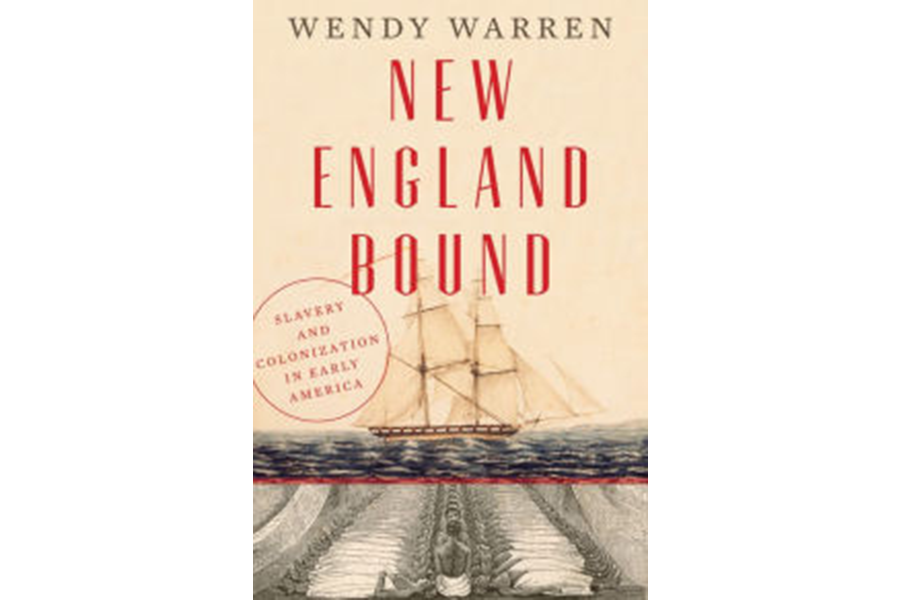'New England Bound' takes a serious look at an often overlooked story
Loading...
The mystery of the break-in at the Democratic National Committee at Watergate in 1972 might have remained unraveled had Deep Throat not spoken three words: Follow the money. The same manner of pulling at a thread can help us to understand the genesis, evolution, and extent of slavery in early colonial New England. Three words: Follow the sugar.
At first blush, Plimouth Plantation, the Massachusetts Bay Colony, and their colonized surrounds hardly seem fertile ground for slavery, with their antiestablishment piety, small agricultural units, and absence of extractive enterprises. But Princeton University historian Wendy Warren, in her zesty New England Bound, begs to differ.
“The tragedy of chattel slavery – inheritable, permanent, and commodified bondage – the problem that dominates the narrative of so many other early English attempts at colonization in North America and the Caribbean, hardly appears in the story of earliest New England. The following pages demonstrate why it should.”
It should because it did; slavery’s presence will no more be skated over. Historians have written penetratingly on North American colonial racism and slavery – Edmund Morgan, Alden Vaughan, Ira Berlin, for starters – but "New England Bound" is a smart contribution to the New England story, a panoptical exploration of how slavery took root like a weed in the crack of a sidewalk.
By Warren’s reckoning, slavery’s expression took many shapes in the colonial New England enterprise between the years 1638 and 1700, the focal years of her study. The first documented shipment of enslaved Africans in Massachusetts Bay took place in 1638 and 1700 marks the publication of "The Selling of Joseph," Bostonian chief justice Samuel Sewall’s essay that stands as New England’s first antislavery tract.
"Joseph" didn’t put a damper on New England slavery; it did, however, represent a sea change in consciousness, as it represented an “individual’s wincing in the face of similar cruelty.... ‘Wee were a people, who did not deale in any such commodities, neither did wee buy or sell one another, or any that had our owne shapes.’” (On the other hand, in one of the many meaningful nuggets that Warren uses to chink and stabilize her narrative, she notes that Sewall was a judge at the Salem witch trials. He apologized.)
Dissent is everywhere and ever, but it would be many decades more before slavery ended in New England.
Warren introduces another branch of slavery by asking a question: How did Squanto – Tisquantum, the Patuxet man who saved what was left of the Pilgrims’ collective hide – come to speak English? Because Squanto had been kidnapped by explorers and sent to England, eventually returned to his home, only to be kidnapped again, and sold into slavery in Spain. He made his way back to his band – this man had pluck – only to find them extinguished. The history of Native American slavery in New England is a story both parallel and perpendicular to New England’s African slavery, and one that Warren trails closely.
Follow the sugar. This point deserves the lucidity that Warren brings to it. New England was a settler colony. The occupation of land was at its essence. Still, to accumulate wealth, both merchant and yeoman needed a market. How convenient then the extractive colonization of the Caribbean, with its sugar and tobacco plantations, and with which New England had strong familial and commercial ties. These plantations required Indian land for planting – Caribbean islands – and land to feed the slaves: that would be Indian land in New England for farming, pasturing livestock, and wood to build ships to carry cargo, such as sugar and tobacco, to Europe.
The natives had to be extirpated. Removal often involved a fight, which legitimatized the enslavement of the native population, thanks to the Bay Colony’s Body of Liberties: “It is ordered by this Court and the authoritie thereof, that there shall never be any bond-slavery, villenage or captivitie amongst us; unless it be lawfull captives, taken in just warrs, and such strangers as willingly sell themselves, or are solde to us.”
Thus, writes Warren: “Slavery was forbidden except for such capacious and ill-defined categories as war captives and legal sales.” As well, the natives were too capable to retaliation, witness the Pequot and King Philip’s wars, whereas the African slaves had no recourse to organization, weaponry, or foreknowledge of the land.
Thus a significant number of Native Americans found themselves being shipped south into slavery, while Africans slaves were being shipped north to New England. The African slaves would prepare the land for planting, clear the forests, collect tar and turpentine, perform household labor, and tend to the numbing jobs. In town, they worked the logistics of distribution and storage, and as mariners. Although there was a wide distribution of slave holding– “‘there is not a house in Boston, however small may be its means, that has not one or two,” – wrote a visitor in 1687, there was also the dreadful excuse of status: “their ownership could both instantiate and substantiate a colonist’s social rank and identity.”
The tone of "New England Bound" occasionally projects a passive-aggressive more-left-than-thou air. Few racists will be avidly devouring this book; Warren is preaching to a choir of inquisitive, sympathetic readers. More irksome – this is not a substantive complaint, just a stylistic one – is Warren's penchant for ending a paragraph like a soap opera before a commercial break: “The Atlantic trade gave, and the trade took,” just as “Sugar made an unyielding master.”
Should such grouses sway one from reading "New England Bound"? Not on your life. What we have in this account is sharp explication of the “deadly symbiosis” of colonization and slavery, written with a governed verve that perks like a coffee pot. It makes the New England story that much fuller, challenging, and more accountable.








